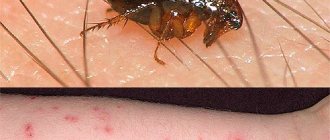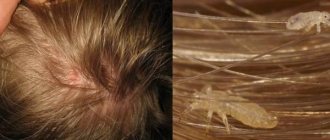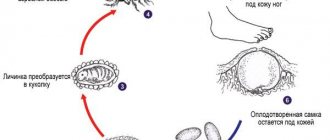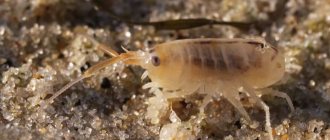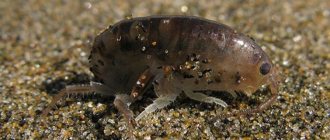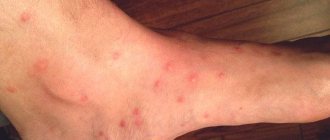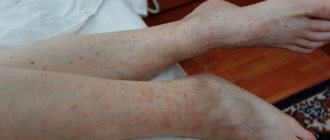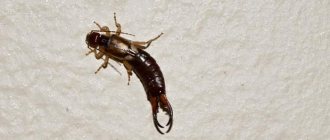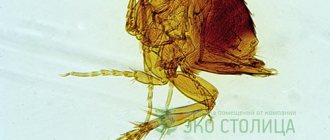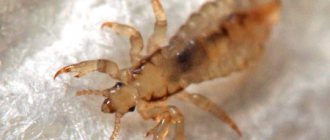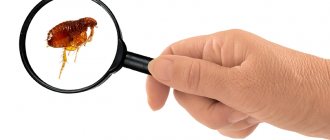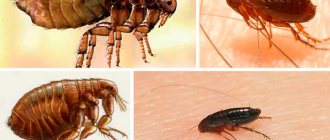Fleas have been “accompanying” human life since the very time when he had his first pet. Typically, these blood-sucking insects parasitize our pets - cats and dogs, and therefore we inevitably encounter them.
Although they adapt to specific animals, when there is a shortage of food, human blood is quite suitable for parasites. Therefore, our article is about what the insect is and how it spreads, what harm it causes to humans, and whether it is possible to get rid of fleas once and for all.
Can dog or cat fleas live on people?
Fleas don't live on humans, but they can still bite us. The most common are cat fleas. They can feed on both cats and dogs, so don't let the name fool you. There are also dog fleas, but they are less common.
Fleas can also feed on other mammals and birds, such as rodents and livestock. There are 2,500 different species of fleas in the world.
Some animals are attracted to fleas because of their fur or feathers. They may burrow into their furry bodies to hide and feed. They then lay eggs, which eventually hatch after the larval and pupal stages. This cycle can cause your pet to become infected with fleas and will need to be treated.
Fleas don't live on humans because we don't have strong fur like animals do, and they have a very difficult time reproducing without the protection of fur or feathers. One laboratory study found that a flea must feed on a human for 12 hours straight to be able to lay viable eggs. It is very rare that a flea can feed on a person for so long without being found and removed.
Appearance of a flea
These are small insects, so it is not always possible to notice them right away. Flea bites are painful, and the site of the bite is “marked” by a pink spot. The body of a flea is on average from 1 to 5 mm, but a well-fed insect has a stretched abdomen, due to which the size increases to 1 cm. The fertilized female reaches a large size - up to 1.5 cm. The body is divided into a head and abdomen, protected by a chitinous shell.
Under a microscope, a flea resembles a shrimp. This is the most convenient body shape, as it helps to move faster through fur or feathers and hide in secluded places. Three pairs of strong limbs allow her to move by jumping. The limbs have claws so that they can cling to fur or any surface.
This is interesting: The lifespan of the parasite ranges from several months to 3 years. How long an insect lives depends on the ambient temperature. High temperatures shorten life expectancy, low temperatures prolong it, since in cool conditions the life cycle proceeds slowly.
The eyes are located on the head, above which are antennae. They are needed so that the male can hold the female during mating. The rest of the time they do not play any role. The spines and bristles covering the skin are a kind of protection, making it almost impossible to comb out a flea.
The color of the parasite varies from yellowish to brown and black. The piercing-sucking mouthparts are designed for feeding. The stylet at the base helps to bite through the host's skin, increasing the size at the site of the bite. The flea injects saliva into the wound to prevent the blood from clotting. She penetrates there with her whole body in search of a blood vessel. The parasite becomes completely saturated in one bite, increasing in size.
This is interesting: Fleas have a special sensory organ - the pygidium, located on the abdomen, in its rear part. The pygidium is covered with hairs that are sensitive and react to any air vibrations, giving a warning signal of danger.
Do fleas bite people or not?
Fleas can bite people, most often on the feet, ankles and legs. They can bite three times in a row. This is called "breakfast, lunch and dinner."
Usually the first bites do not cause damage to the skin, but if a person is exposed to fleas for a long period of time, a hypersensitivity reaction may develop.
What does a flea bite look like on the human body?
The visual effects of flea bites can last for several days, but may get worse if you are more sensitive to the bites or if the area of the bite becomes infected.
Signs of a parasite
Do fleas live on people? Permanently - no, parasites live on the fur of pets for a long time. They visit a person to have a hearty and satisfying meal, and then they can move onto a cat or into the carpet pile. These are not lice that live on the body permanently. Fleas live on humans only while they feed. Therefore, the question: are fleas transmitted from cats to humans is itself formulated incorrectly. There is no talk of any transfer from one owner to another.
Article on the topic: What is the difference between fleas and lice
Vampire fleas only quench their thirst, after which the female can hide in a secluded, dark and damp place to lay eggs. Males can live in animal bedding or garbage. Therefore, contaminated bedding, basements, and garbage cans can be a source of danger from which an attack will occur.
All secluded corners where annoying blood-sucking creatures hide are located close to warm-blooded animals and humans. They remain invisible and disappear after a bite. How fleas bite has been described before. If the skin is sensitive, the bite may be painful and small reddish spots may appear on the body. Fleas will attack constantly, so you need to know where they live:
- in the cracks of the floor between the boards,
- under the baseboard or threshold,
- in the pile of carpets and upholstered furniture,
- in linen and bedspreads, especially fluffy ones,
- in storerooms and basements,
- in the bedding of domestic animals.
Here they can reproduce, lay eggs and attack their potential victims.
Note: The development cycle of the parasite ranges from 2 weeks to a month, depending on living conditions. A larva emerges from the cocoon and searches for a host. If this happens en masse, large colonies develop. Up to 200 individuals can “live” in the fur of one animal at the same time.
Do fleas pose any other dangers to people, pets or homes?
Fleas are more than a nuisance. In fact, they can cause several serious illnesses and can be fatal to animals if the infestation is so severe that it affects overall health.
Flea diseases
Fleas can carry several different diseases that can be transmitted through a bite. The most common are plague and typhus.
Both of these diseases are caused by bacteria and require treatment, such as antibiotics.
Allergic reactions
A flea bite can cause an allergic skin reaction because your body reacts strongly to the flea's saliva.
An allergic reaction to a bite can cause flea dermatitis. It may cause the following symptoms:
- irritated, red skin
- severe itching
- hives
- infection
Allergic reactions to flea bites can also occur in animals. An allergic reaction may cause the animal to scratch the bites to the point where skin appears or hair falls out.
Risk of tapeworm infection
Fleas can carry tapeworms. If you or an animal ingest a flea, you may become infected with a tapeworm. Children may be more likely to accidentally ingest a flea.
Tapeworms may not cause any harm to your overall health or the health of your pet, but if you notice something white and similar to a pumpkin seed in your or your pet's feces, it could be a sign of tapeworms. If you suspect this, contact your doctor or veterinarian.
Treatment of bites
The bite area is immediately washed with soapy water and disinfected with alcohol. Ice helps relieve swelling.
At home, honey and lemon lotions and used tea bags are used. Apply compresses with a decoction of mint, plantain, bird cherry, and dandelion leaves.
Allergic reactions are eliminated with the help of antihistamines, antipyretics and sedatives. Special ointments are effective, for example Fenistil.
How to get rid of a flea infestation
You will need to treat both your pet and clean the house if you suspect a flea infestation. There are several ways to get rid of fleas.
How to remove fleas from your pet
- Talk to your veterinarian about the safest and most effective method for removing fleas.
- When caring for your pet, use a flea comb.
- Before bathing, leave the soap on your pet for at least 5-10 minutes.
- Use a veterinarian-prescribed flea medication that kills fleas.
- Follow directions for using over-the-counter flea products carefully.
- Protect your pet by not using flea removers on his eyes, nose, and mouth.
- Wear gloves and other protective equipment when applying flea removers.
How to Remove Fleas from Your Home or Yard
- Wash pet beds and other fabric toys or rugs in hot water.
- Vacuum thoroughly and place any debris collected by the vacuum cleaner in a plastic bag, sealing it and disposing of it immediately.
- Apply insecticides to baseboards, but make sure they are not harmful to pets.
- Clean all upholstery (furniture, rugs, carpet, window bedding) frequently.
- Seal holes where wild animals can enter or near your home.
- Remove trash from around your home.
- If you suspect you have a serious flea infestation, call a pest control service.
Is it easy for a person to get fleas?
There is no need to think that fleas appear in people only where there is dirt, garbage and chaos. Of course, without proper sanitation, the risk of flea infestation increases significantly. But fleas can also appear even where hygiene is taken care of. Fleas live wherever there are animals. You can pick them up at the zoo, on a farm, hunting, or while walking in the forest or park. You can bring them from any public place, transport, or work. Even on the playground there can be fleas, because not only children can walk there, but also cats or dogs on their own.
In older homes, fleas can live for decades in basements and attics. There they feed not on the blood of domestic animals, but on rats or mice, which is even more dangerous, since rodents are carriers of the most dangerous diseases, and fleas, by biting them, spread these diseases further. In such houses, residents constantly suffer from infestations of fleas that come from common areas, utility rooms into apartments.
How to prevent fleas from spreading in your home
You can avoid flea infestations in your home in several ways, such as:
- Check your pet regularly for fleas
- clean your pet's sleeping place
- Don't let your pet go into places where there may be fleas from other animals, such as barns
Let's sum it up
Fleas can bite people, but they live on animals and in their bedding areas. Flea bites can be irritating and cause more serious health problems that require treatment from a doctor. Make sure you monitor your pets regularly for fleas and keep your home clean to reduce the likelihood of a flea infestation.
Sources:
Impulse follows strict sourcing guidelines and relies on peer-reviewed studies, research institutions and medical associations. We avoid using insufficiently expert links.
- Cat flea. (n.d.). portal.ct.gov/CAES/Fact-Sheets/Entomology/Cat-Flea
- Fleas. (2008). extension.entm.purdue.edu/publichealth/insects/flea.html
- Fleas. (2018). betterhealth.vic.gov.au/health/ConditionsAndTreatments/fleas
- Garcia E, et al. (2004). Immune and histopathologic examination of flea bite-induced papular urticaria. DOI: 10.1016/S1081-1206(10)61781-4
- Houseman, R.M. (2014). Fleas. extension2.missouri.edu/g7380
- Youssefi, M.R., et al. (2014). Dermatitis caused by Ctenocephalides felis (cat flea) in human. ncbi.nlm.nih.gov/pmc/articles/PMC4247491
Medicines from the pharmacy.
The doctor will prescribe medications based on the symptoms and external manifestations of the allergy. Most often this is Fenistil gel, hydrocortisone ointment, Zvezdochka balm, Miramistin, Flucinar, Sulfur ointment.
Let's take a closer look at some of the drugs.
- Fenistil gel. A product that quickly and effectively relieves swelling and itching.
- Hydrocortisone ointment. A strong hormonal drug, it has side effects, so it is used only as a last resort.
- Star. The composition with menthol and eucalyptus will relieve pain and swelling. Rub it every half hour on the bite sites until the wounds heal. It is worth noting that the composition of the balm is quite aggressive; if the wounds begin to fester, then you cannot apply Zvezdochka.
- Miramistin. A good antiseptic, it will cleanse the skin of particles of flea saliva and prevent infections from spreading.
- Flucinar. Hormonal ointment, used in serious cases. Flucinar is contraindicated at the beginning of pregnancy, children under two years of age and after vaccinations.
- Sulfuric ointment. Sulfur has a disinfecting and antiseptic effect.
All of the drugs listed above have contraindications; before use, be sure to read the instructions and consult your doctor.
Measures to combat the human flea
To remove parasites, one, even the most drastic, measure is not enough. We need a set of measures that will allow you to get rid of insects for a long time:
- Treatment of the entire apartment. It doesn’t matter that fleas “attack” only one room. When using folk or chemical remedies in a room, they move to another part of the home and the final place of stay is the bathroom, which should not be ignored.
- Cleaning of all rooms: collecting dust in secluded places (behind cabinets, under baseboards, in gaps between furniture). It is advisable to vacuum the entire apartment, and in the most thorough manner. Constant wet cleaning is important.
- Things and clothing also provide additional shelter for fleas. They are subjected to hot washing and steam treatment or ironing with a hot iron. Pillows and mattresses can be placed in the sun, where fleas are killed by exposure to UV rays and high temperatures.
If there are few parasites, then mechanical control measures can solve the problem. With their large population, insecticides are indispensable. Treatment is carried out with special aerosols, using Executioner, Combat, Raptor, Dobrokhim, Tsifoks and other drugs.
The product is left on the surfaces for several hours (based on the instructions), after which the apartment is thoroughly washed. During this period, households and living organisms should not be in the room, since most insecticides are toxic not only to insects, but also to warm-blooded animals.
Infusions are helpful, the specific smell of which repels fleas. For example, an infusion of a mixture of wormwood, tansy and eucalyptus forces insects to leave their homes. The product is safe and effective. It is sprayed with a spray bottle, carefully treating furniture and floors.
It is almost impossible to kill a flea by simple mechanical action, since it has a strong, laterally flattened body covered with chitinous scales. This method of struggle is not effective.
Preventive measures.
Preventing fleas is easier than fighting them. For prevention purposes, follow these simple recommendations:
- Cleanliness is the key to freedom from pests. Pay special attention to secluded places where it is difficult to clean.
- Fill all gaps in baseboards, window frames and doorways.
- Provide your animals with flea collars.
- Frequently and promptly wash the rugs on which your pets sleep and rest.
- Place bouquets of aromatic herbs in the corners to repel insects.
- Periodically wipe all surfaces in the house with a soda solution.
If you find at least one individual flea, do not put off fighting them until later, call a special pest control service.
Life cycle of a flea
Life cycle of a flea
The flea is a blood-sucking insect that feeds exclusively on the blood of warm-blooded mammals. The insect is 1-3 mm in size and usually has a color ranging from red to brown-black. The eggs of the parasite are similar in appearance to grains of white semolina, but the black dots that can be seen in the animal’s fur are their excrement.
How to avoid re-infection?
After treatment, it is important to prevent re-infection of the apartment, so people and pets also undergo disinfection. For disinfection, people use tar soap, which is suitable for both adults and children.
Four-legged inhabitants are dug with special means and after a while a flea collar is put on to prevent re-infestation. You can use anti-parasite shampoo, which can be purchased at a pet store. Close attention should be paid to the litter. It is processed especially carefully: washed with hot water, steamed and (if possible) dried in the open air under the sun.
To completely eliminate the new infestation of human fleas, it is better to contact professional services that guarantee the quality of treatment using the most modern and safe means.
